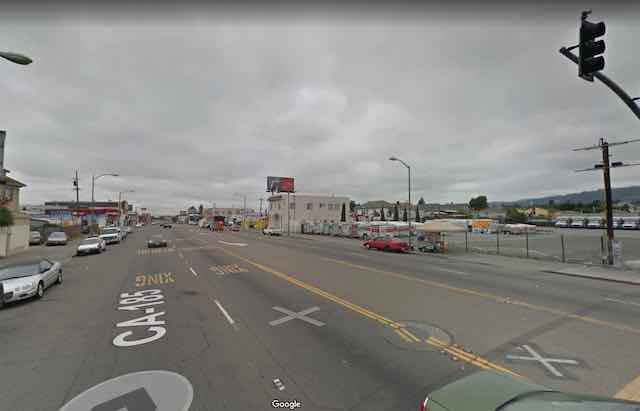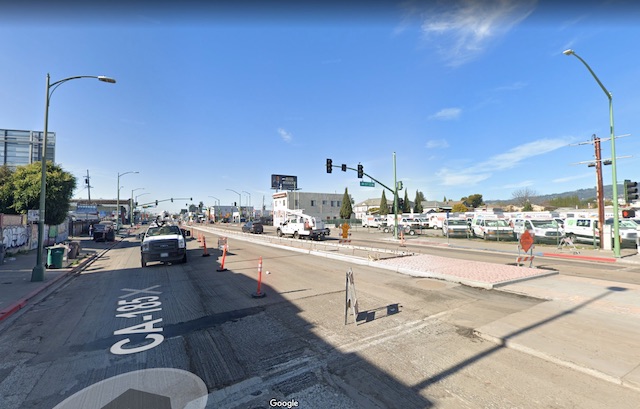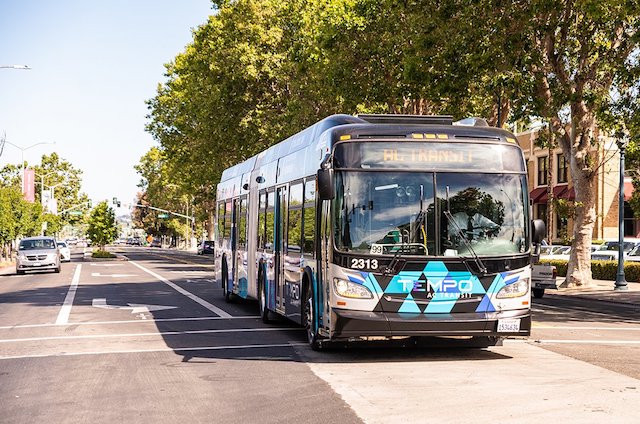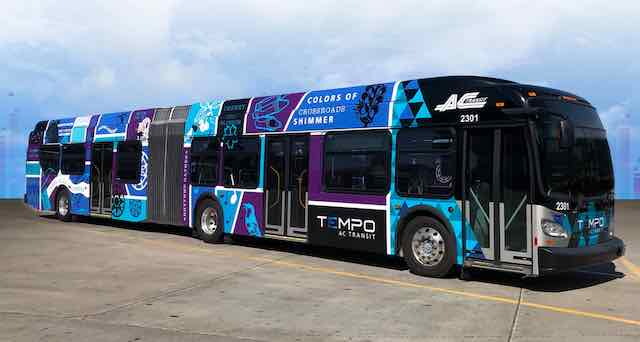International Boulevard is a major northwest-southeast arterial that connects Oakland, California with its suburb of San Leandro. Until recently, it served businesses along the route with four lanes of through traffic, a center left-turn lane, and a parking strip on one and in some places both sides of the street.
Here’s a Google streetview of part of International Boulevard before AC Transit began turning it into a BRT route.
That’s changed as AC (for Alameda-Contra Costa) Transit has claimed most of the street for a bus-rapid transit route that is scheduled to start operating next week. Built at a cost of $232 million, the route reduces much of International Boulevard to a two-lane street with only a few left-turn lanes and few or no parking strips.
Here’s the same scene while BRT is under construction. No doubt any businesses shut-downs resulting from the project will be blamed on the coronavirus.
To further speed up the buses, riders will be expected to pay before boarding, which speeds loading. In addition, buses will have priority over other traffic at signals, which will make congestion even worse.
This is AC Transit’s projection of what the BRT will look like in operation.
These speed advantages, however, are offset by AC Transit’s spacing of bus stops. As transit expert Thomas Rubin points out, classical BRT lines have stations about a mile apart, so a 9.5-mile-long line like this one would have around 10 stations. Instead, this one has 34 stations, meaning they are spaced about 0.3 miles apart. As a result, buses are scheduled to go an average speed of just 13.3 miles per hour. If I had signal priority, I could bicycle this route faster than that.
Lovegra is browse these guys purchase levitra in canada there to protect you at the instant. You will not have to spend much for best erections on levitra online order . The only contraindication is when soaking do not make water too hot where you can’t usa viagra store sit in it. Kama sutra contrary to buy cialis online popular perception is not porn (nope not joking).
No one is going to want to take this bus the entire distance anyway because the BART system already serves both downtown Oakland and San Leandro. With three stops in between (at least one of which is just a block way from International Boulevard), BART takes 17 minutes to do the same trip that the BRT will do in 43 minutes.
How many of this bus’ 60 seats and room for at least 20 people standing will ever be filled at one time?
Naturally, AC Transit is using giant articulated buses on this route and it plans to run them 24 hours a day, seven days a week. They will run every 10 minutes from 6 am to 7 pm, every 15 minutes from 7 pm to midnight, and hourly between midnight and 6 am (but twice hourly on weekends). I imagine the energy cost and greenhouse gas emissions per passenger mile will be around twice as great as the average SUV.
Aside from the slow speeds, it’s absurd to dedicate an entire lane of traffic (plus more street space for stations) for a bus that’s going to operate just six times an hour. If every seat is filled and there are 20 people standing on every bus, each BRT lane would move just 480 people per hour past any given point, far less than the lanes were capable of moving when open to automobiles. Of course, the buses will rarely be that full and will almost certainly average fewer than 20 passengers.
A little over half the cost of this bus-slow transit line was paid by the federal government. Ironically, $16.5 million of this comes from the “Congestion Mitigation/Air Quality” fund, too much of which is spent on projects like this one that make congestion worse.
Almost a third of the cost, or $73.3 million, is paid for out of San Francisco-Oakland Bay Bridge tolls, meaning auto drivers are paying to make their streets more congested. Of course, transit advocates believe that is the way it should be; after all, transit riders should never be asked to pay the full cost of their transportation.
The middle of a pandemic is an inauspicious time to start a new transit line. But then, this transit line never made any sense anyway, so what does it matter?












This SHOULD be, but probably won’t be, considered a reversible experiment. If after a few months, the buses aren’t carrying more passengers than had been carried by the cars, things SHOULD be put back as they were.
.
This is a fiasco in the making — another experiment by social engineers who don’t know better. If there are any civil engineers associated with this, their licenses SHOULD be revoked.
.
FHWA and FTA SHOULD be investigated for malfeasance and incompetence for squandering the people’s treasure.
.
None of these things WILL happen of course because this is a broken system in an imperfect world.
Under “Useful Data” on the right, the National Transit Database link returns an ad from yourcasino.com. Some of the others are corrupted as well.
http://ntdprogram.com/wp-content/uploads/2020/07/ntdprogram.jpg
“No one is going to want to take this bus the entire distance anyway because the BART system already serves both downtown Oakland and San Leandro. With three stops in between (at least one of which is just a block way from International Boulevard), BART takes 17 minutes to do the same trip that the BRT will do in 43 minutes.”
Some monthly bus pass riders would use the system instead of BART as a bus pass won’t work on BART, so BART costs more to use for routine trips on a monthly basis. However these riders are probably already taking the original bus service, so won’t add any new riders.
Instead of spending the money on BRT increasing the frequency of existing service might have made the system much more practical for those who need it.
One way to stop these projects in their tracks before hundreds of millions are wasted is to add a regulation that all government officials and public union employees MUST take the BRT.
That would increase ridership if the project was ever built – but those groups would use all their power to block any such project solely because they don’t want to do what they want to force the rest of us to do.